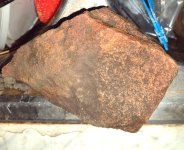Bucket Lister
Hero Member
- Dec 20, 2023
- 983
- 1,755
- Detector(s) used
- XP Dēus II
XP MI-6
XP WSA II-XL
- Primary Interest:
- Metal Detecting
Is there a list of rocks & minerals that will set off metal detectors?
I found such a stone today--it was infuriating!!!! 🤬
After several minutes of sifting through substrate with my pinpointer expecting to find another rusty square nail, all that was left was one stone. It doesn't set off the pinpointer like being in contact with a piece of metal, but it does set it off--like being a few inches away.
No, it's not being set off by my keys or pocket change--BT-DT. 😳
I found such a stone today--it was infuriating!!!! 🤬
After several minutes of sifting through substrate with my pinpointer expecting to find another rusty square nail, all that was left was one stone. It doesn't set off the pinpointer like being in contact with a piece of metal, but it does set it off--like being a few inches away.
No, it's not being set off by my keys or pocket change--BT-DT. 😳
Upvote
3









